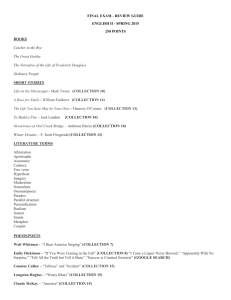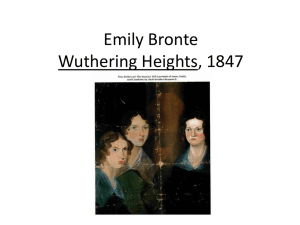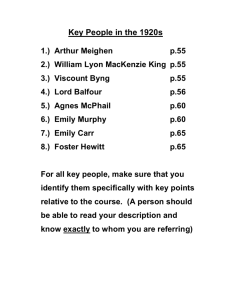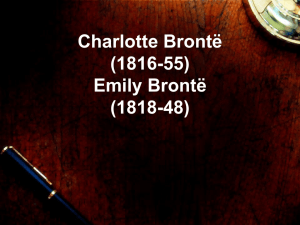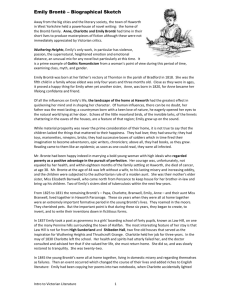Wuthering Heights - Henry County Schools
advertisement
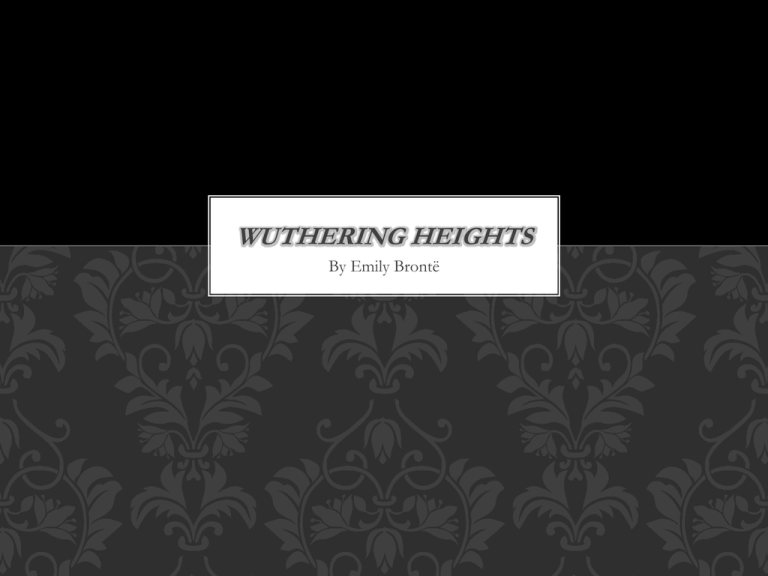
WUTHERING HEIGHTS By Emily Brontë EMILY BRONTE Born on July 30, 1818, the fifth of six children of Maria and Patrick Brontë Within a year and a half of moving to Haworth where Patrick was the rector, Maria died. Maria and Elizabeth, the two eldest daughters, died in 1825 of tuberculosis contracted at the Clergy Daughters’ School; Emily and Charlotte returned home from school. Since their father was an eccentric recluse and their aunt disliked the harsh weather, the Brontë children entertained themselves on the moors, isolated from the world. The children created the imaginary worlds of Angria and Gondal; they wrote their tales in miniscule script. Although Emily left Haworth twice, she returned quickly to her beloved countryside and took care of her father. Later, when her brother Branwell returned home in disgrace after being dismissed from a tutoring job, Emily cared for him as well. He became addicted to opium and alcohol (Hindley?) CURRER, ELLIS AND ACTON BELL Charlotte, Emily, and Anne collaborated on a book of poetry in an effort to make money and chose masculine pseudonyms to maintain anonymity and to avoid prejudice against female authors. Their collected poems sold two copies. Charlotte published in 1847 as Currer Bell. Anne’s and Emily’s were also published in 1847 as Acton and Ellis Bell, respectively. According to Charlotte’s biographer, Elizabeth Gaskwell, Emily sorely felt “the pangs of disappointment as review after review came out”; it was believed to be “a disagreeable story” with “coarse” characters, and “the nightmare of a recluse.” In September of 1848, Branwell died. Emily caught a cold at his funeral and died of consumption in December of that same year at the age of thirty, a year after the publication of . SETTING High Sunderland Hall – this is the home Brontë Modeled Wuthering Heights after this home Shibden Hall Ponden Hall Both Shibden and Ponden Halls are believed to be the models of Thrushcross Grange THE ROMANTIC PERIOD 1789-1832 The term Romantic is like Janus, the Roman god of doorways, who had two faces, one looking backward and one looking forward. Romantic is a word signifying both beginnings and endings. The most notable Romantic poets were ; these three were known as the first generation. They were influenced by the French Revolution, Napoleon, and the Industrial Revolution. They looked backward to Milton and Shakespeare and looked forward by creating new forms of lyric poetry. The second generation included . They were upset with the repressive atmosphere in England in 1815 (just after the Napoleonic Wars). They looked backward to Milton and Shakespeare and looked forward by writing poems that were thought to be visionary and extravagant. SOME CHARACTERISTICS OF ROMANTICISM FOUND IN WUTHERING HEIGHTS: The love of nature is presented in its tranquil and smiling aspects as well as its wild, storminess Nature is a living, vitalizing force and offers a refuge from the constraints of civilization The concern with identity and the creation of the self are a primary concern Focus is placed on the individual that society matters little Heathcliff is the Byronic hero in that both are rebellious, passionate, misanthropic, isolated, and wilful; both have mysterious origins, lack family ties, reject external restrictions and control, and seek to resolve their isolation by fusing with a love object. The passion driving Catherine and Heathcliff and their obsessive love for each other are the center of their being and transcend death GOTHIC CHARACTERISTICS A castle, ruined or intact, haunted or not Extreme landscapes Magic, supernatural manifestations, or the suggestion of the supernatural A passion-driven, wilful vaillain-hero or villain A curious heroine with a tendency to faint and a need to be rescued Horrifying or terrifying events of the threat of such happenings Boundaries are trespassed (life and death + Heathcliff ’s transgressing social class and family ties Imprisonment and escape, flight, the persecuted heroine, the heroine wooed by a dangerous and a good suitor, ghosts, necrophilia, a mysterious foundling, and revenge RECURRING MOTIFS, SUBJECTS FOR DISCUSSION, AND THEMES Clash of storm and calm, discord and harmony, past and present, nature and nurture, reason and passion, the civilized and the primitive Clash of economic interests and social classes Striving for transcendence Abusive patriarch and patriarchal family Abuse of children and the family Self-imposed or self-generated confinement and escape Displacement, dispossession, and exile Communication and understanding The fall Revenge Defying conventional standards Marriage
